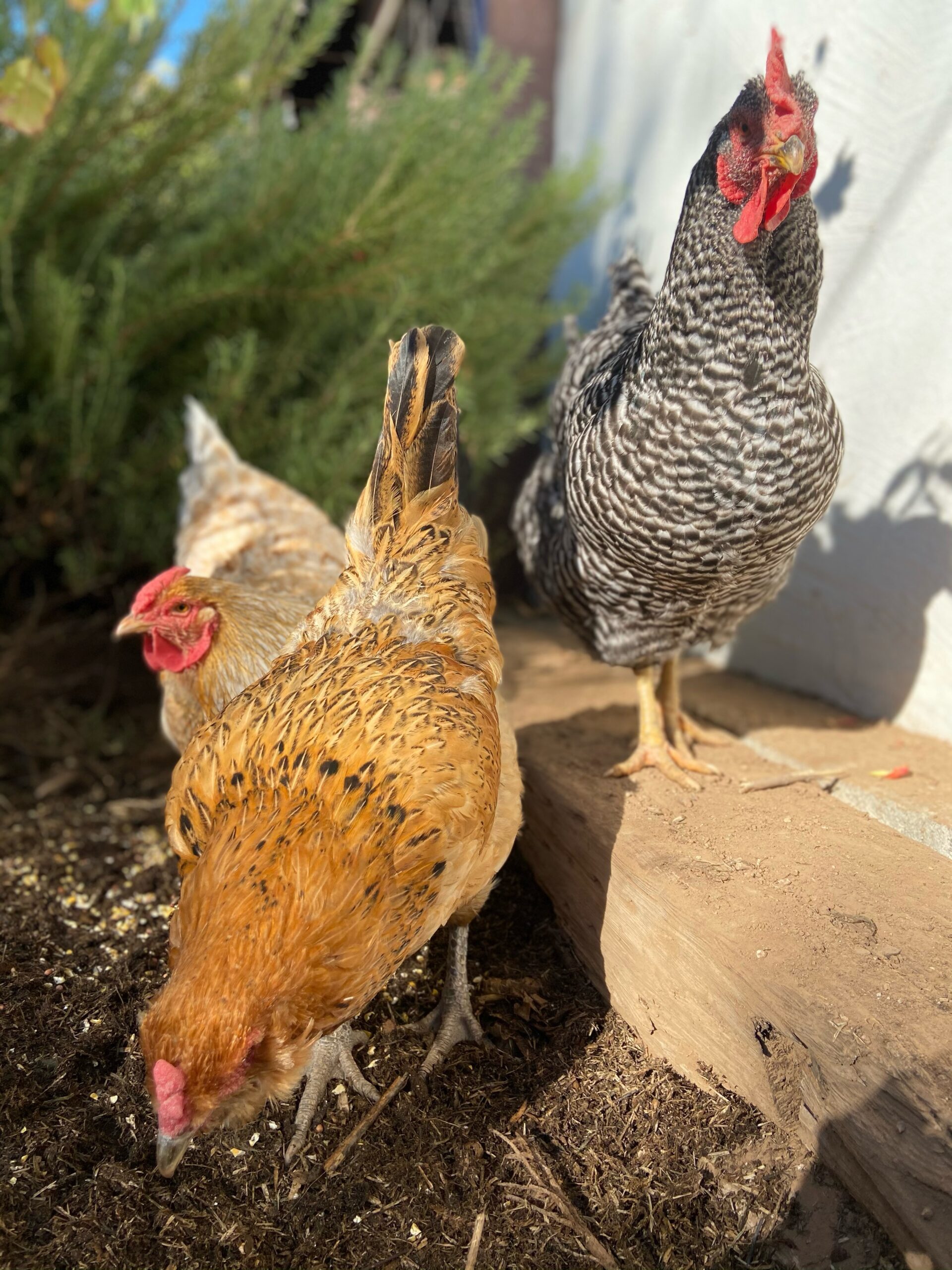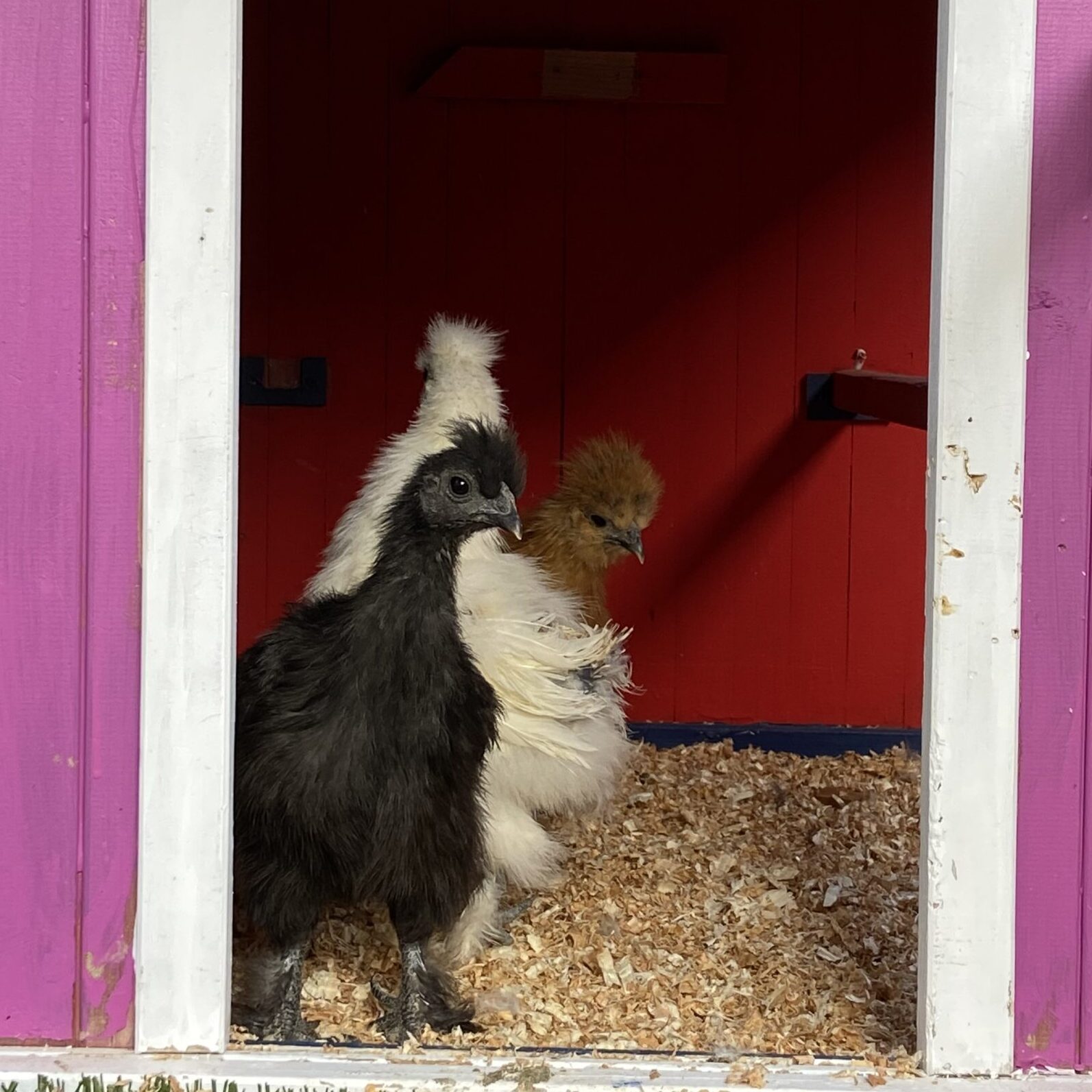How to Choose a Chicken Breed
Not all chickens are created equal. Chickens have been bred to meet different purposes, and you must take that into consideration when deciding what breed(s) to raise.
Will you be raising chickens for meat, eggs, therapy animals, or something else? What environment do you live in? Will your chickens free range, or do you have a defined space for them?
Things you will find on this page:
7 things to consider when choosing a chicken breed
How to choose a good egg layer
Considerations for sourcing healthy chickens
Recommended books to help you choose a breed

7 Things to consider when choosing a chicken breed:

1. Zoning
Are there any zoning restrictions in your area for keeping chickens?
This may seem unrelated, but zoning sometimes affects how many chickens you are allowed to keep, whether you can keep hens or roosters, and whether you can process your own meat birds.
If you live in an area where you can only keep 6 chickens and you are raising hens for eggs, you may want to choose breeds that tend to lay a higher yearly average, like Rhode Island Red chickens, rather than birds bred for meat like Cornish hens.

2. Purpose
Do you want to raise chickens for eggs, meat, dual purpose, therapy, or all?
Chicken breeds have been bred for certain traits over many, many years. Some are amazing egg layers, some grow muscle fast and are used for meat, and some are a mix of good egg layers and good meat birds. Maybe you don’t care about their production value, and you just want a fun pet or therapy animal.
Broiler Chickens
Broiler Chickens: any chicken that is bred and raised specifically for meat production. These chickens are usually smaller than egg layers and grow muscle much faster. Most commercial broilers reach slaughter weight between four and six weeks of age, although slower growing breeds reach slaughter weight at approximately 14 weeks of age. Broiler chicken breeds can still lay eggs, but are usually slaughtered before egg laying begins (around 18 weeks).
Originally, chickens in the USA were dual purpose breeds.
Broiler (meat) chickens were not sold commercially until the early 1920s. Mrs. Wilmer Steele is credited as the pioneer of the broiler industry, when she raised a flock of 500 chicks in 1923, intended to be sold for meat. By 1926, she had earned enough money to build a broiler house large enough to hold 10,000 chickens. (National Poultry Council). (Secrets of the Eastern Shore)
Egg Layers
Egg Layers (A.K.A. “Eggers”): Divided into heavy and light breeds, these chickens have been bred specifically to lay a lot of eggs. Good egg layers lay between 150 and 350 eggs a year.
Dual Purpose
Dual Purpose: breeds that are both good egg layers and suitable for processing.
Therapy Chickens
Maybe you don’t care about how many eggs your hens lay or if they are a good source of meat because you want to keep chickens for the therapy benefits they provide.
Therapy Chickens: chickens that are friendly and calm temperd.
2. Purpose
Do you want to raise chickens for eggs, meat, dual purpose, therapy, or all?
Chicken breeds have been bred for certain traits over many, many years. Some are amazing egg layers, some grow muscle fast and are used for meat, and some are a mix of good egg layers and good meat birds. Maybe you don’t care about their production value, and you just want a fun pet or therapy animal.
Broiler Chickens
Broiler Chickens: any chicken that is bred and raised specifically for meat production. These chickens are usually smaller than egg layers and grow muscle much faster. Most commercial broilers reach slaughter weight between four and six weeks of age, although slower growing breeds reach slaughter weight at approximately 14 weeks of age. Broiler chicken breeds can still lay eggs, but are usually slaughtered before egg laying begins (around 18 weeks).
Originally, chickens in the USA were dual purpose breeds.
Broiler (meat) chickens were not sold commercially until the early 1920s. Mrs. Wilmer Steele is credited as the pioneer of the broiler industry, when she raised a flock of 500 chicks in 1923, intended to be sold for meat. By 1926, she had earned enough money to build a broiler house large enough to hold 10,000 chickens. (National Poultry Council). (Secrets of the Eastern Shore)
Egg Layers
Egg Layers (A.K.A. “Eggers”): Divided into heavy and light breeds, these chickens have been bred specifically to lay a lot of eggs. Good egg layers lay between 150 and 350 eggs a year.
Dual Purpose
Dual Purpose: breeds that are both good egg layers and suitable for processing.
Therapy Chickens
Maybe you don’t care about how many eggs your hens lay or if they are a good source of meat because you want to keep chickens for the therapy benefits they provide.
Therapy Chickens: chickens that are friendly and calm temperd.
2. Purpose
Do you want to raise chickens for eggs, meat, dual purpose, therapy, or all?
Chicken breeds have been bred for certain traits over many, many years. Some are amazing egg layers, some grow muscle fast and are used for meat, and some are a mix of good egg layers and good meat birds. Maybe you don’t care about their production value, and you just want a fun pet or therapy animal.
Broiler Chickens
Broiler Chickens: any chicken that is bred and raised specifically for meat production. These chickens are usually smaller than egg layers and grow muscle much faster. Most commercial broilers reach slaughter weight between four and six weeks of age, although slower growing breeds reach slaughter weight at approximately 14 weeks of age. Broiler chicken breeds can still lay eggs, but are usually slaughtered before egg laying begins (around 18 weeks).
Originally, chickens in the USA were dual purpose breeds.
Broiler (meat) chickens were not sold commercially until the early 1920s. Mrs. Wilmer Steele is credited as the pioneer of the broiler industry, when she raised a flock of 500 chicks in 1923, intended to be sold for meat. By 1926, she had earned enough money to build a broiler house large enough to hold 10,000 chickens. (National Poultry Council). (Secrets of the Eastern Shore)
Egg Layers
Egg Layers (A.K.A. “Eggers”): Divided into heavy and light breeds, these chickens have been bred specifically to lay a lot of eggs. Good egg layers lay between 150 and 350 eggs a year.
Dual Purpose
Dual Purpose: breeds that are both good egg layers and suitable for processing.
Therapy Chickens
Maybe you don’t care about how many eggs your hens lay or if they are a good source of meat because you want to keep chickens for the therapy benefits they provide.
Therapy Chickens: chickens that are friendly and calm temperd.
Choosing a Good Egg Layer
Check out this video from our friends at Carter’s Farms to find out how to choose a good egg-laying breed to raise.
If you still have questions about how to choose the right breed for your farm, please message us!
3. Environment
What climate do you live in?
Certain chicken breeds do better in different climates because of their biology. They regulate heat using their combs, waddles, and body size.
Cold-Tolerant Breeds
If you live some place extremely cold (averages under 30°F in the winter), consider getting a chicken with a small comb (like a peacomb or a rose comb) and waddle, and thick feathers. They will not lose body heat through their comb as readily as other breeds with large combs, and you reduce the risk of frostbite in the winter. Good breeds for this climate include easter eggers, Australorps, and silkie bantams. Orpingtons are also cold hardy, even though they can have larger combs.
- Other cold-tolerant breeds include: Wyandottes, Rhode Island Reds, New Hampshire Reds, Barred Rocks, Delawares, Brahmas and Salmon Favorelles.
Heat-Tolerant Breeds
If you live someplace that can be extremely hot (averages above 90° in the summer), consider getting a breed with a large comb (like a single comb or a buttercup comb).
- Common heat-tolerant breeds inlcude Wyandotes, Rhode Island Reds, Orpingtons, Leghorns, and Easter Eggers.
3. Environment
What climate do you live in?
Certain chicken breeds do better in different climates because of their biology. They regulate heat using their combs, waddles, and body size.
Cold-Tolerant Breeds
If you live some place extremely cold (averages under 30°F in the winter), consider getting a chicken with a small comb (like a peacomb or a rose comb) and waddle, and thick feathers. They will not lose body heat through their comb as readily as other breeds with large combs, and you reduce the risk of frostbite in the winter. Good breeds for this climate include easter eggers, Australorps, and silkie bantams. Orpingtons are also cold hardy, even though they can have larger combs.
- Other cold-tolerant breeds include: Wyandottes, Rhode Island Reds, New Hampshire Reds, Barred Rocks, Delawares, Brahmas and Salmon Favorelles.
Heat-Tolerant Breeds
If you live someplace that can be extremely hot (averages above 90° in the summer), consider getting a breed with a large comb (like a single comb or a buttercup comb).
- Common heat-tolerant breeds inlcude Wyandotes, Rhode Island Reds, Orpingtons, Leghorns, and Easter Eggers.
4. Space
How much space do you have?
Larger breeds like dual purpose breeds require more space than small bantam breeds. Each bird should have 2-4 square feet (0.2-0.4 square meters) of indoor space, and 10 square feet (1 meter) of outdoor space.
Common spaces to keep chickens:
- Free range acreage
- Free range backyard
- Walk-in enclosed run
- Small, enclosed run
- House chicken
4. Space
How much space do you have?
Larger breeds like dual purpose breeds require more space than small bantam breeds. Each bird should have 2-4 square feet (0.2-0.4 square meters) of indoor space, and 10 square feet (1 meter) of outdoor space.
Common spaces to keep chickens:
- Free range acreage
- Free range backyard
- Walk-in enclosed run
- Small, enclosed run
- House chicken
5. Kids
Do you have kids/will your chickens be around kids a lot?
Some breeds are better temperaments around kids than others. If you have kids, you want to select a breed with a mild temperament, curious, playful, and not flighty. Orpingtons, Silkies, and Barred Plymouth Rock chickens are our favorites around kids because all three are fun, curious breeds, with a generally calm demeanor.
You can train most any chicken to be good around kids, but it comes naturally to these three.
Kids tend to make a lot of noise, wave random toys, and chase chickens. You want to choose a breed that will not be bothered by these traits.
5. Kids
Do you have kids/will your chickens be around kids a lot?
Some breeds are better temperaments around kids than others. If you have kids, you want to select a breed with a mild temperament, curious, playful, and not flighty. Orpingtons, Silkies, and Barred Plymouth Rock chickens are our favorites around kids because all three are fun, curious breeds, with a generally calm demeanor.
You can train most any chicken to be good around kids, but it comes naturally to these three.
Kids tend to make a lot of noise, wave random toys, and chase chickens. You want to choose a breed that will not be bothered by these traits.
6. Cost
Some breeds are more expensive than others! Especially specialty breeds.
Ayam Cemani chickens can run about $90 for a single chick, whereas a more common breed, like a Rhode Island Red can run $2-5 per chick.

6. Cost
Some breeds are more expensive than others! Especially specialty breeds.
Ayam Cemani chickens can run about $90 for a single chick, whereas a more common breed, like a Rhode Island Red can run $2-5 per chick.

7. Personal Preference
Do you want to rasie a particular breed because you like how they look or because of the color eggs they lay?
As you may come to find, some chicken keepers purchase chickens based on egg color, feather pattern, or specialty breed. This is your flock! Raise what you want.
If you are not raising chickens to sell eggs, the average number of eggs a hen lays a year may not matter as much to you as someone trying to make a living off of egg sales. Alternatively, you may sell eggs and find that a particular color egg (such as chocolate eggs from a Black Copper Maran or bright blue eggs from an Easter Egger) can be sold for a higher price.
7. Personal Preference
Do you want to rasie a particular breed because you like how they look or because of the color eggs they lay?
As you may come to find, some chicken keepers purchase chickens based on egg color, feather pattern, or specialty breed. This is your flock! Raise what you want.
If you are not raising chickens to sell eggs, the average number of eggs a hen lays a year may not matter as much to you as someone trying to make a living off of egg sales. Alternatively, you may sell eggs and find that a particular color egg (such as chocolate eggs from a Black Copper Maran or bright blue eggs from an Easter Egger) can be sold for a higher price.
Recommended Books and other Resources about Chicken Breeds
There are so many great resources with information about chicken breeds available, but here are a few!
Considerations for Sourcing Healthy Chickens
Visit our blog to learn about how to choose a reputable source for your chickens and how to choose healthy chicks!
